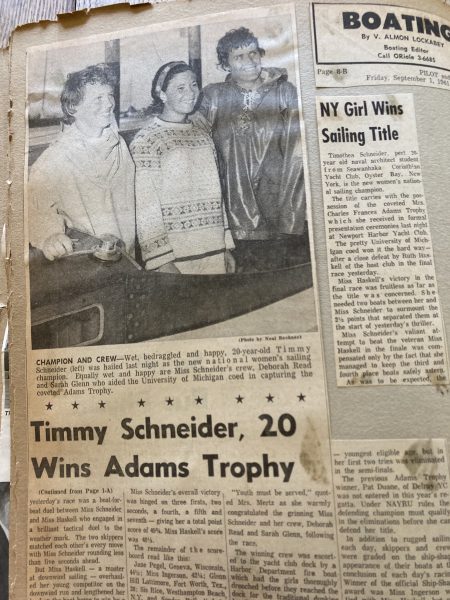
Inspiration: When she was a teenager, Marilee’s family in Newport Beach, CA hosted Adams Cup winner Timothea Schneider (left). Naval architect, 3-time U.S. Women’s Sailing Champion and National Sailing Hall of Fame member Timmy Larr is an exemplary role model for women in sailing. “I remember that day well!” Marilee enthuses.
Women racing sailboats isn’t new. The picture on the cover of Mystic Seaport Museum’s book on women and boating, On Land and On Sea, depicts the wife of an English lord at the helm of a massive J boat. In barely two generations from that time, women’s sailing has catapulted to an international sport across hundreds of countries.
In the next two issues, we’ll present a few moments in time over the last fifty years of women’s competitive sailing. In this first installment we visit with one of the trailblazers in women’s sailing, captain of a 1970s dynasty at the college level and the first woman elected to the Intercollegiate Hall of Fame. She is our Princeton classmate Marilee Allan from Newport Beach, CA, who recalls those early days on the college circuit from 1971 to ’75.
Marilee Jane Allan was the first female intercollegiate skipper I ever met. In September 1971, she had come to Princeton University from Newport Beach in Orange County as part of the first full class of freshman women. Her father, Robert Allan, was a prominent Southern California businessman with a string of boats from a Fishers Island 31 to the West Coast offshore icon, the Cal 40. Her brothers were offshore and one-design rock stars. Out east, we did not know her regional reputation, but she became the nucleus of a Princeton Women’s Sailing Team that became a dynasty in the 1970s, winning Nationals 1973 -‘77, a string yet to be matched.
Over 52 years, Marilee and I have kept our dialogue on sailing. For this conversation, we connected on Zoom from her home in Wailea, Maui, dangerously close to the catastrophic fire in neighboring Lahaina. She was right off the plane from her home in the East Bay. It was a two-person game of pickup basketball, reminiscing and reminding each other of what happened way back when (interview edited for length and clarity).
TD: I’m here with Marilee Allan, who I’ve known for many, many years – more years than either one of us would like to admit. We were classmates at Princeton, Class of 1975. We were sailing counterparts, although I don’t recall sailing together in a boat, but she was really the hub of what became a dynasty in the 1970s at the beginning of Women’s college sailing.
MJA: Thanks, Tom. I think we probably met in the first week at college. You’re right, but I think we were on some McMillan Cup boats together [a collegiate big boat series held at the Naval Academy each fall]. We practiced and were certainly on the team, which wasn’t huge at the time.
I was born into a sailing family. I have three older brothers, and I was the kid who just hung around. I started sailing (racing) about age five or six. My family grew up in Newport Beach. My oldest brother Skip, who is nine years older than me, is a pretty famous sailor in the big boat world, but he also raced in college and growing up he was in Star boats alongside Bill Ficker and all kinds of folk and racing in World Championships even at 13 and 15. Scott (my other sailing brother) similarly did very well at USC and before that racing Snipes including the Snipe Nationals. I’m trying to remember. It’s back a ways…
I watched my brothers, nine years and seven and a half years older, racing and doing well in college when I was just a pipsqueak and racing myself. The third brother is a surfer and fisherman – he could sail but he never really raced. So we would go and race in Newport Beach, we’d race over to Catalina in big boats and small boats. I did well in something called a Snowbird, won the championship in that.
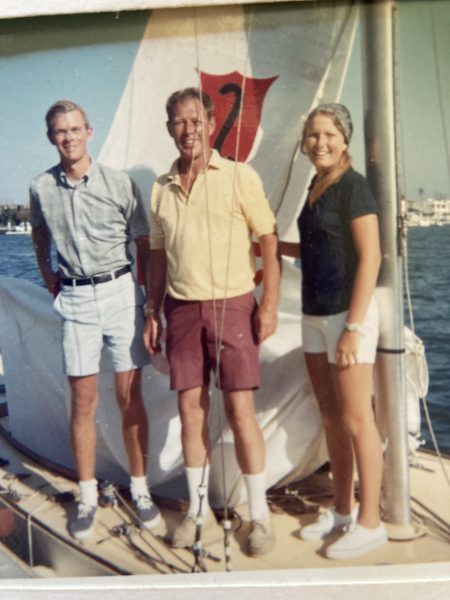
Marilee Allan, from a Southern California racing family, is pictured here circa 1970 after winning the Shields Western Regional Championship before heading east to college sailing.
TD: Oh, those funny little West Coast catboats.
MJA: Yeah, they had a Flight of the Snowbirds that would take over the whole bay, and I was the youngest to be first.
TD: You didn’t sail Sabots?
MJA: I inherited my brother’s Sabot. It seemed to weigh more than any of the other Sabots, and didn’t do well. I quickly launched into the Snowbird, which was a two-person boat, but I was the skipper. Nina Nielsen (the late Hall of Fame skipper from Princeton) was a year younger than me and she did really well in Sabots and was racing all over California. And we were buddies. We were very, very different temperamentally, but we were very good friends so there was this comfortable, fun yet competitive world in Newport. And they did have some college sailing, even then. That built up over time with UC Irvine coming and a whole bunch of boats being donated from the East Coast by Cornelius Shields, the Shields boats. And I remember the Adams Cup winner Timothy Larr staying at our house.
So, I had different aspirations. I really did well in the Snowbirds and something called a Kite which was a little closer to what a Laser would be. Newport generally had a pretty strong 15 miles an hour. It wasn’t like the East Coast or San Francisco Bay, but that’s what I grew up in.
I won the Western Regional Shields Championships when I was 16, beating college sailors from USC and others. And I remember one of my Newport Harbor YC guy sailors saying, “I’m so burned up getting beat by a girl.” I already had this nascent women’s lib stuff that didn’t even exist yet; Gloria Steinem wasn’t around at this time. I didn’t want to miss high school, so I didn’t go to the Shields Nationals. But the guy who was third in Regionals won it, so that made me feel really good. And I was in Sports Illustrated “Faces in the Crowd” at 16.
I applied to Princeton thinking, “Oh, I’ll just go to Stanford. That’s what my brother and my dad and my mom did.” But I was intrigued by Princeton when I got in and thinking, “Yes, I’m gonna do this.” It was the third class of women and the senior class was mostly all men. And apparently, the Sailing team knew I was coming.
TD: I was in the first class where women entered as freshmen.
MJA: That’s probably true. We as women were getting into sports at Princeton, and the Sailing team, I guess through my brother, who knew Chris Wilson’s brother Peter Wilson (crew on the 12 Metre Intrepid). He had spread the world and they expected me and so I was planning to race just as I had in the real world and done well. We, you and I, met at one of the first Sailing team evening meetings. There were races scheduled and they had female crew, but I don’t think they’d had a female skipper. But that was fine. We were, you know, in the brand-new world of male colleges with women.
I don’t remember how it happened, but Royce Flippin, the head of Athletics, said, “Oh, we have an agreement with the Ivies that women don’t compete in varsity sports. You can’t race here.” I said, “Excuse me?” and we got into a 25-minute heated discussion. I said, “Why would I come to this school and be told I can’t race, which I do in the real world?” I had a whole knockdown with him, and maybe that discourse had me become a lawyer later. Eventually he said, “OK, just do it. But don’t race on any women’s teams.” I laughed and went ahead.
But there was a new world, so I mostly raced the regular college events that existed, and we all split up who was skippering where. There were some very strong junior class skippers that tended to skipper, but in practices you and I found that we could beat them!
Certainly, people counted me out too, because I was West Coast and had red- blonde hair. They thought, “Who is this woman?” But I liked to hold my own, and I convinced Nina [Nielsen, also Hall of Fame] to come the next year so we really started having a good time.
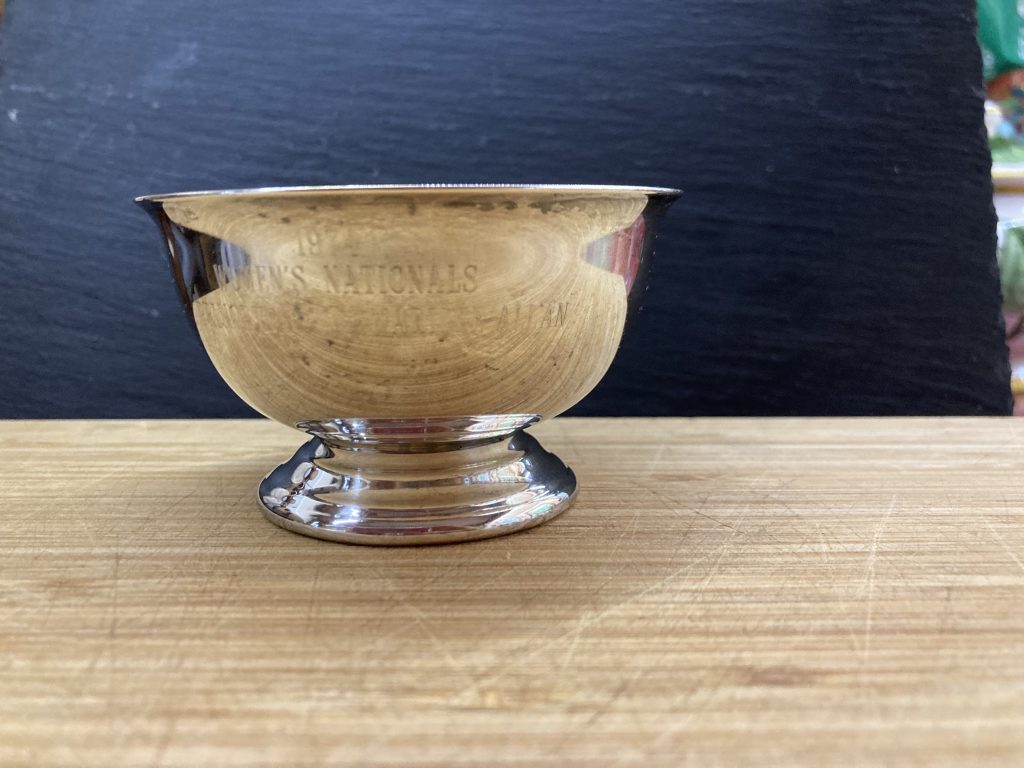
Winners’ trophy for the first Princeton Women’s Team National Championship, 1974
TD: What do you remember of the first National championship?
MJA: I think it was my junior year, and it happened to be set a year or two in advance in Newport Beach where I had grown up and we had Nina. Our main competitors at that point were Radcliffe. Nina and I would either of us sail A or B. And for whatever reason the fellow who was picking, Chris Wilson, who was a boyfriend, had one skipper B and Nina A but it didn’t really matter and we both did really well. The first day Nina did really well, the second day we both did. Nina definitely won A. I tied for B and we won. Well, the Harvard coach, Mike Horn, who is a pretty well known coach and sailor said, “Oh, local knowledge!” Well, Princeton went on to win it three more years at least after me.
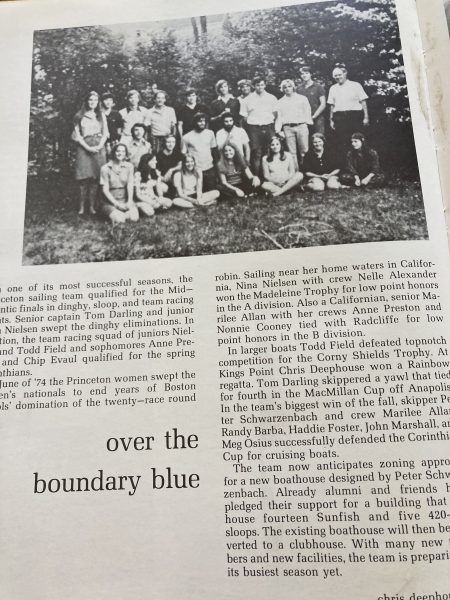
From the 1975 Princeton yearbook
TD: I was coaching them in 1977 and I remember that. Yeah, you were a dynasty.
MJA: We loved it. And you know, we got along well. In addition to Nina, Anne Preston was an amazing sailor from Connecticut, then Noonie Cooney who was my crew, and Nelle Alexander was terrific. Nina and I tended to be the skippers at least until we graduated. That was 1976 for Nina and after that Dorothy Bedford, whom I didn’t really know well.
We were strong, and we attracted other people to come and the team was growing, and I raced big boats in the McMillan Cup. I got married right after graduating, so it was a whole new world raising three kids and then forty years of practicing environmental law.
TD: You are more of a windsurfer than a sailor now…
MJA: I found windsurfing about nine years ago and I have boards around. I’m in Maui now with boards here, and I have boards back in Berkeley where I live. I’d say I’m Intermediate. I can water start but I’m not doing rapid jibes and heavy winds…but I plan to go later today.
TD: What’s the story of being elected to the Intercollegiate Hall of Fame?
MJA: Oh my gosh, it just happened. They didn’t let women be All Americans as sailors. And in that first year, I’m sure that Nina and a number of others that sailed well in college went in. Princeton was in the front of the Ivies in letting women in, so they put us in the Hall of Fame instead of making us All Americans. They said, “You would have been an all American if we had it, so we are putting you in the Hall of fame. I have a certificate
TD: Thanks, Marilee and hopefully we get out on the water together soon.
Postscript: Nina Nielsen and Marilee Allan were inducted into the Intercollegiate Hall of Fame in 1994. Nina, Class of 1976, passed away in January 2011 at her home in Newport Beach from an apparent pulmonary embolism. She was 56. There is a foundation in her name for the Sailing Team at Princeton dedicated to keeping the team moving, literally, transported to regattas. We in the Princeton sailing community all miss her terribly. Her daughter, Caroline Horton was a junior sailing star and in her own way in her 20s keeps Nina’s dogged competitive flame alive.
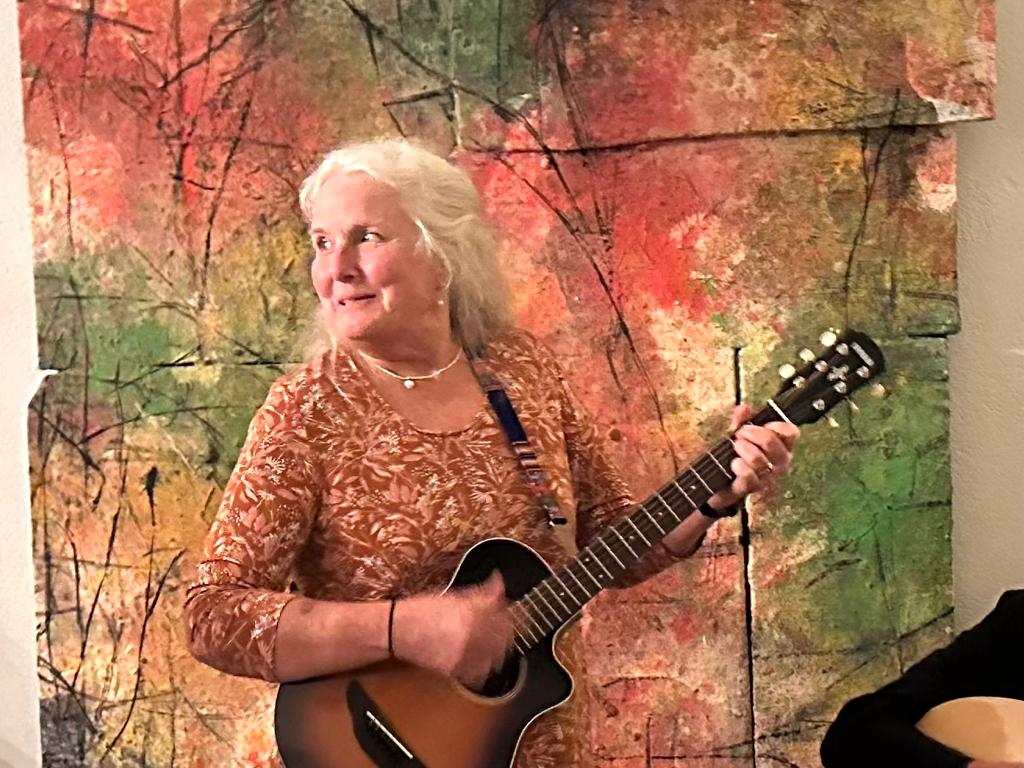
Snowbirds to Intercollegiate Hall of Fame: Marilee Jane Allan entertaining friends.
In our next edition we’ll bring you the story of the 1985 Women’s World Keelboat Championship, an iconic early international women’s sailing event. Held in the other Newport (in the Ocean State), this regatta featured skippers and crews that went on to be Olympians when Women’s Sailing was included in 1988. We will feature 1985’s winning skipper, Betsy Alison and her crew (Josenhans, Darling, Shore and Sertl) as they become top dog among their 36 American and foreign competitors. Dodging Hurricane Gloria on the water and off, competitors in the Rolex International Women’s Keelboat Championship garnered world media and sailing community recognition.■
Not an historian but a boat storyteller, collecting and reciting stories for the boating curious, Tom Darling is the host of Conversations with Classic Boats, “the podcast that talks to boats.” Tune in via Apple Podcast, Google Podcast or Spotify, or online at conversationswithclassicboats.com.

My hat is off to you, dear Marliee! What an accomplished family you guys are ! I hope to see you very soon- wow !